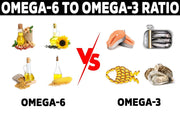
In the evolving health landscape of Pakistan, understanding the roles of essential fatty acids is crucial. Among these, Omega-3 and Omega-6 fatty acids stand out due to their significant impact on overall well-being. While both are vital, maintaining a proper balance between them is key to preventing chronic diseases and promoting optimal health.
Understanding Omega-3 and Omega-6 Fatty Acids
Omega-3 Fatty Acids are polyunsaturated fats known for their anti-inflammatory properties. They play a pivotal role in brain function, heart health, and reducing inflammation. Primary sources include:
-
Fatty fish (e.g., salmon, mackerel)
-
Flaxseeds
-
Chia seeds
-
Walnuts
Omega-6 Fatty Acids, also polyunsaturated, are essential for growth and development. However, excessive intake can lead to inflammation. Common sources are:
-
Vegetable oils (e.g., corn, soybean)
-
Processed foods
-
Nuts and seeds
The Importance of Balance
The ratio of Omega-6 to Omega-3 fatty acids in the diet is crucial. Historically, humans consumed these fats in a ratio of approximately 1:1. Modern diets, however, often have ratios as high as 20:1, favoring Omega-6. This imbalance is associated with increased inflammation and a higher risk of chronic diseases such as heart disease, arthritis, and certain cancers.
Health Implications of Imbalance
An excess of Omega-6 fatty acids, relative to Omega-3s, can lead to:
-
Increased inflammation
-
Higher risk of cardiovascular diseases
-
Potential for mood disorders
Conversely, adequate Omega-3 intake supports:
-
Heart health
-
Cognitive function
-
Joint health
Achieving the Right Balance
To restore balance:
-
Increase intake of Omega-3-rich foods
-
Reduce consumption of processed foods high in Omega-6
-
Consider supplementation with high-quality Omega-3 products
Recommended Product:
Everseas Omega-3 Softgels by SOIS Life Sciences
These softgels are halal-certified and provide a potent dose of EPA and DHA, supporting overall health and helping to correct the Omega-6 to Omega-3 imbalance.
Conclusion
Maintaining a balanced intake of Omega-3 and Omega-6 fatty acids is essential for optimal health. In Pakistan, where dietary patterns are shifting, being mindful of this balance can help prevent chronic diseases and promote well-being. Incorporating Omega-3-rich foods and considering supplementation with products like Everseas Omega-3 Softgels can be effective steps toward achieving this balance.
Research References
-
Healthline: How to Optimize Your Omega-6 to Omega-3 Ratio
-
ScienceDirect: The associations between dietary omega-6, omega-3, and omega 6 to omega 3 ratio intake and the risk of developing hypertension
-
MindBodyGreen: Omega-3 vs. Omega-6: Key Differences Between These Fatty Acids
-
Dr. Weil: Balancing Omega-3 And Omega-6
-
University Health News: Omega-6 vs. Omega-3 Fatty Acids: What You Should Know




















